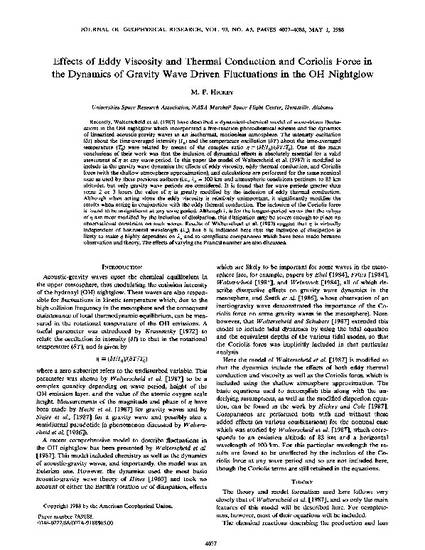
Recently, Walterscheid et al. (1987) have described a dynamical-chemical model of wave-driven fluctuations in the OH nightglow which incorporated a five-reaction photochemical scheme and the dynamics of linearized acoustic-gravity waves in an isothermal, motionless atmosphere. The intensity oscillation (δI) about the time-averaged intensity (I0) and the temperature oscillation (δT) about the time-averaged temperature (T0) were related by means of the complex ratio η ≡ (δI/I0)/(δT/T0). One of the main conclusions of their work was that the inclusion of dynamical effects is absolutely essential for a valid assessment of η at any wave period. In this paper the model of Walterscheid et al. (1987) is modified to include in the gravity wave dynamics the effects of eddy viscosity, eddy thermal conduction, and Coriolis force (with the shallow atmosphere approximation), and calculations are performed for the same nominal case as used by these previous authors (i.e., λx = 100 km and atmospheric conditions pertinent to 83 km altitude), but only gravity wave periods are considered. It is found that for wave periods greater than some 2 or 3 hours the value of η is greatly modified by the inclusion of eddy thermal conduction. Although when acting alone the eddy viscosity is relatively unimportant, it significantly modifies the results when acting in conjunction with the eddy thermal conduction. The inclusion of the Coriolis force is found to be insignificant at any wave period. Although it is for the longest-period waves that the values of η are most modified by the inclusion of dissipation, this dissipation may be severe enough to place an observational constraint on such waves. Results of Walterscheid et al. (1987) suggest that η is virtually independent of horizontal wavelength (λx), but it is indicated here that the inclusion of dissipation is likely to make η highly dependent on λx and to complicate comparisons which have been made between observation and theory. The effects of varying the Prandtl number are also discussed.
